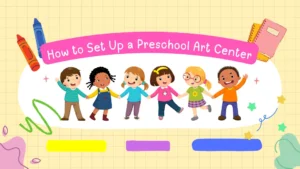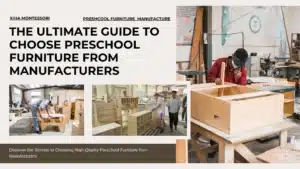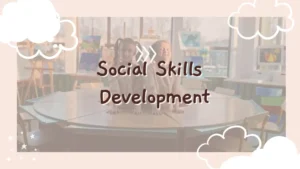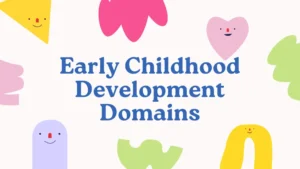Preschoolers are naturally curious and eager to explore the world around them. However, finding the right questions to stimulate their thinking can be challenging. Open-ended questions are an excellent way to accomplish this! Open-ended questions are a wonderful tool to engage your little one’s curious mind and encourage them to express their thoughts and feelings. By asking questions with multiple possible answers, you can stimulate your child’s imagination, creativity and communication skills.
Open-ended questions cannot be answered with a simple yes or no, and they encourage children to think deeply and express themselves more freely. By asking these questions, active learning is promoted and a love of exploration and discovery is fostered.
In this post, I’ll explore the benefits and share some of the best open-ended questions for preschoolers.
What Are Open-Ended Questions?
Open-ended questions cannot be answered with a simple “yes” or “no” response. Instead, they require more thought and encourage children to express their ideas, feelings, and understanding more elaborately.
Open-ended questions often start with words like “why,” “how,” “what,” “tell me about,” and “describe.” They encourage detailed responses and critical thinking. These questions stimulate conversation, critical thinking, and creativity, making them particularly valuable in early childhood education.
Why Are Open-Ended Questions Important?
Open-ended questions are crucial in early childhood education for several reasons. They help children develop foundational skills for their future learning and social interactions.
- Encourages Critical Thinking: Open-ended questions stimulate children’s thinking processes, allowing them to analyze, evaluate, and create new ideas. This helps develop their problem-solving skills and cognitive abilities.
- Enhances Language Skills: These questions require more elaborate responses than yes or no answers, promoting the use of more complex language structures. This expands their vocabulary and improves their ability to express thoughts and ideas clearly.
- Fosters Creativity and Imagination: Preschoolers are encouraged to think outside the box and develop creative solutions or stories when asked open-ended questions. This nurtures their imagination and innovative thinking.
- Builds Confidence: Answering open-ended questions helps children gain confidence in their ideas and opinions. They learn their thoughts are valuable and worth sharing, boosting their self-esteem.
- Encourages Engagement and Participation: Open-ended questions invite children to participate more actively in conversations. They feel more involved and interested when they can contribute their ideas and perspectives.
- Develops Social Skills: Engaging in conversations with open-ended questions helps preschoolers learn to listen to others, take turns speaking, and respect different viewpoints. This is crucial for their social development and interactions with peers and adults.
- Supports Emotional Development: These questions often touch on feelings and experiences, allowing children to explore and articulate their emotions. This helps them better understand and manage their feelings, contributing to emotional intelligence.

The Difference Between Open-Ended and Closed-Ended Questions
The difference between open-ended and closed-ended questions for preschool children lies like the responses they elicit and their impact on their development. Open-ended questions require more elaborate answers and stimulate a child’s critical thinking, creativity, and language skills. For example, asking a child, “What did you like most about your day?” encourages them to reflect, use descriptive language, and express their feelings and thoughts. This type of question allows children to explore ideas, engage in conversation, and develop cognitive abilities.
Closed-ended questions can be answered with a simple “yes” or “no” or specific information. For instance, “Did you play outside today?” requires only a brief response and does not encourage further discussion or exploration. While closed-ended questions are useful for quickly obtaining specific information, they do not promote the same level of cognitive engagement or language development as open-ended questions.
In summary, open-ended questions for preschool children foster deeper thinking, creativity, and language development by encouraging detailed responses and active conversation participation. In contrast, closed-ended questions are more straightforward, requiring minimal thought and often leading to limited interaction.
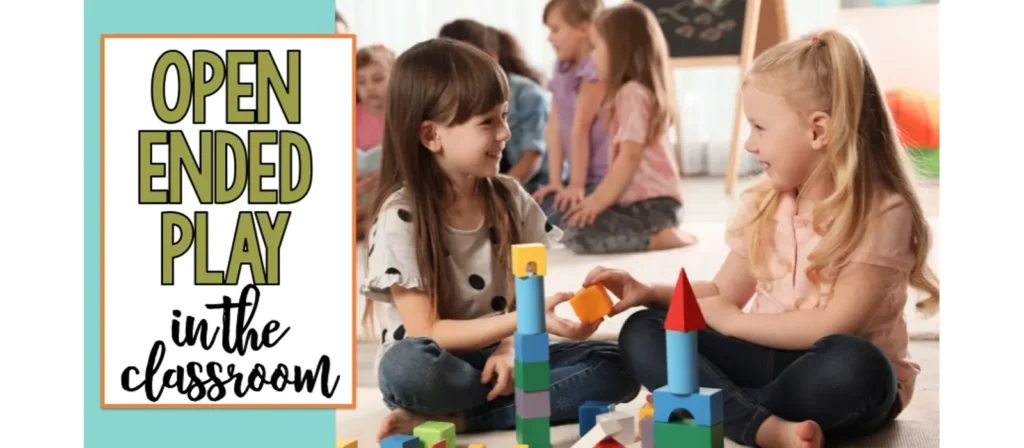
Using Open-Ended Questions in a Play-Based Classroom
In a play-based classroom, open-ended questions can be a powerful tool to foster children’s learning, creativity, and social skills. Here are some strategies and examples of how to use open-ended questions effectively in a play-based setting:
Strategies for Using Open-Ended Questions
Integrate Questions Naturally:
- Ask questions during playtime, activities, and transitions without interrupting the flow of play.
- Example: While children build with blocks, ask, “What are you constructing today?”
Encourage Group Discussions:
- Use questions to facilitate group discussions and encourage children to share their ideas with peers.
- Example: During circle time, ask, “What did everyone enjoy most about our outdoor play?”
Follow the Child’s Lead:
- Observe what interests the children and ask questions about their activities and choices.
- Example: If a child is playing with animal figurines, ask, “What do you think the animals are doing in their habitat?”
Promote Critical Thinking and Problem-Solving:
- Use questions to encourage children to think critically and develop solutions during play.
- Example: When a tower of blocks falls, ask, “What can we do to make it stand taller and stronger?”
Encourage Reflection and Expression:
- After activities, ask questions to encourage children to reflect on their experiences and express their feelings.
- Example: After a painting activity, ask, “How did you decide what colors to use in your painting?”
Stimulate Imagination and Creativity:
- Ask questions that invite children to use their imagination and think creatively.
- Example: While playing dress-up, ask, “If you were a superhero, what powers would you have and how would you use them?”
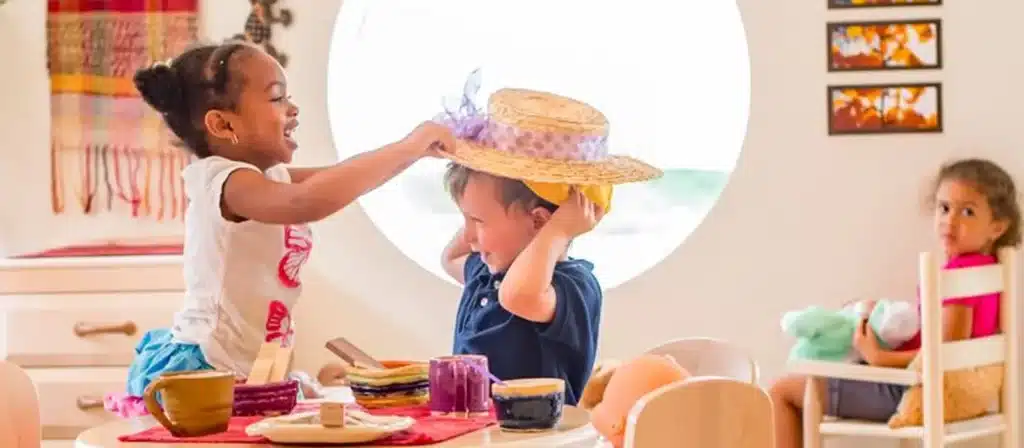
Examples of Open-Ended Questions in Different Play Scenarios
Block Play:
- “What are you building with the blocks?”
- “How can we make this structure even bigger?”
- “What happens if we use different shapes in our building?”
Art Activities:
- “What story does your picture tell?”
- “What materials do you need to create your art project?”
- “How did you choose the colors for your painting?”
Dramatic Play:
- “Who are you pretending to be today?”
- “What happens next in your story?”
- “How can we set up our play area to look like a store?”
Science Exploration:
- “What do you think will happen if we mix these two substances?”
- “How can we find out more about these insects we found?”
- “What do you notice about the plants in our garden?”
Outdoor Play:
- “What can we find on our nature walk?”
- “How can we build a shelter with the materials we have?”
- “What games can we create with the things we see outside?”
Music and Movement:
- “How does this music make you feel?”
- “What kind of dance can you make to this song?”
- “What sounds can you create with these instruments?”
Sensory Play:
- “What does this material feel like?”
- “What can we create with the sand and water?”
- “How do the textures change when we mix them?”
Educators can create a rich, engaging, and supportive learning environment that encourages children to explore, think critically, and express themselves creatively by incorporating open-ended questions into a play-based classroom.
Types of Open-Ended Questions for Preschoolers
Understanding the various open-ended questions can help you tailor your interactions to support a child’s development effectively. Here, we’ll explore seven open-ended questions that can stimulate different aspects of a child’s thinking and learning.
1. Make connections
Questions that help children connect their experiences and new information are crucial for cognitive development. These questions encourage them to relate new concepts to their existing knowledge.
- Examples:
- “Can you think of a time when you felt the same way?”
- “How does this remind you of something we’ve done before?”
- “What does this story make you think about?”
These questions help children build a deeper understanding of the world by connecting new information to what they already know.
2. Predict questions
Prediction questions encourage children to think ahead and consider possible outcomes. This type of questioning promotes foresight and analytical thinking.
- Examples:
- “What do you think will happen next in the story?”
- “What might happen if we mix these two colors?”
- “How do you think this experiment will turn out?”
By asking prediction questions, you help children develop their ability to anticipate and hypothesize, essential problem-solving, and scientific thinking skills.
3. Make an opinion
Encouraging children to form and express their opinions helps them develop critical thinking and communication skills. These questions invite them to consider their preferences and justify their choices.
- Examples:
- “What do you like best about this activity?”
- “Which character in the story do you think is the most interesting? Why?”
- “How do you feel about what happened in the story?”
Opinion questions support children in developing their viewpoints and learning to articulate their reasoning, which is vital for effective communication.
4. Make inferences
Inference questions require children to read between the lines and draw conclusions based on the information provided. These questions are essential for developing comprehension and analytical skills.
- Examples:
- “Why do you think the character did that?”
- “What do you think is happening in this picture?”
- “How can you tell that the character is feeling sad?”
Children learn to interpret information and understand deeper meanings by making inferences and enhancing their reading and listening comprehension.
5. Problem solve
Problem-solving questions encourage children to think creatively and consider multiple solutions to a given problem. These questions help develop their critical thinking and decision-making skills.
- Examples:
- “What could we do to make sure everyone gets a turn?”
- “How can we fix this broken toy?”
- “What would you do if you were the teacher for a day?”
Problem-solving questions foster a sense of independence and resourcefulness as children learn to navigate challenges and develop solutions independently.
6. Create questions
Creative questions inspire children to use their imagination and think outside the box. These questions encourage innovation and original thinking.
- Examples:
- “What new game can you create with these blocks?”
- “How would you design a new playground?”
- “What kind of story can you make up about this picture?”
Creativity questions are essential for developing a child’s ability to think imaginatively and inventively, which is crucial for innovation and artistic expression.
7. Think questions
Think questions challenge children to reflect deeply on their thoughts, feelings, and actions. These questions promote introspection and self-awareness.
- Examples:
- “What did you learn from this activity?”
- “How did you feel when you completed the puzzle?”
- “Why do you think it’s important to share?”
Reflective questions help children better understand themselves and their actions, fostering emotional intelligence and personal growth.
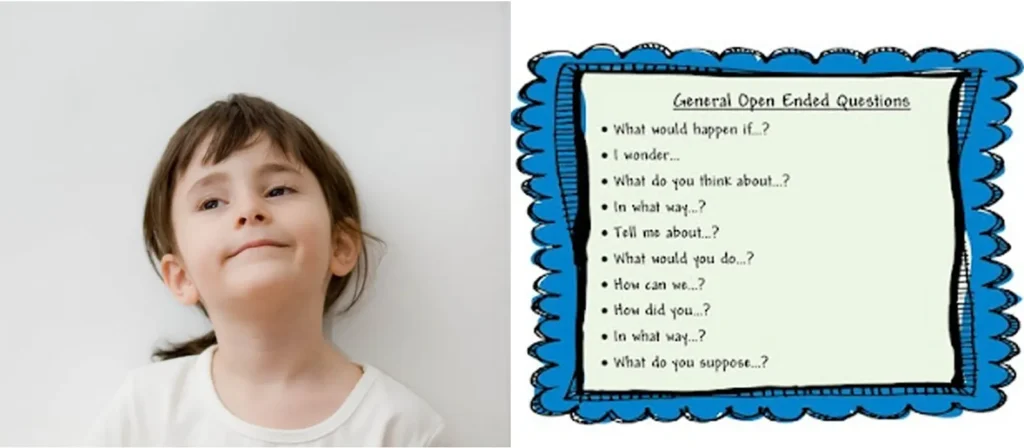
Best Tips for Asking Open-Ended Questions
Asking open-ended questions to preschoolers can significantly enhance their cognitive, language, and social skills. Here are some of the best tips for effectively asking open-ended questions to young children:
1. Use clear, simple language
Simple language helps children focus on the content of the question rather than struggling with complex vocabulary. Use age-appropriate words and keep sentences short and straightforward.
Example: Instead of asking, “What are your thoughts on the narrative of this book?” you could say, “What do you think about this story?”
2. Start with “What,” “Why,” “How,” or “Tell me about”
These starters open the conversation and invite children to share their thoughts and experiences. Begin your questions with these words to elicit more elaborate responses.
Example: “What did you enjoy most about our trip today?” or “How did you feel when you finished your drawing?”
3. Ask interesting questions
Interesting questions capture children’s attention and make them more excited to respond. Think about what interests your child and frame your questions around those topics.
Example: “Why do you think the sky changes colors?” or “What would you do if you found a magic wand?”
4. Avoid leading questions
They can stifle creativity and discourage children from expressing their true thoughts. Frame your questions neutrally to allow for a range of responses.
Example: Instead of asking, “Don’t you think the story was fun?” say, “What did you think about the story?”
5. Allow waiting time
Waiting time shows that you value their thoughts and allow them to answer more thoughtfully. After asking a question, wait patiently and avoid interrupting or prompting too quickly.
Example: Ask your question, then silently count to ten to give the child time to respond.
6. Encourage thinking and reflection
It helps children think critically and reflect on their answers, enhancing their understanding. Ask questions that require them to explain their reasoning or consider different perspectives.
Example: “Can you tell me more about why you chose that color?” or “How do you think the character felt at the end of the story?”
7. Show interest in their answers
It boosts their confidence and encourages them to share more. Maintain eye contact, nod, and provide verbal affirmations.
Example: Respond with, “That’s very interesting! Can you tell me more about that?”
8. Emphasize the process rather than the correct answer
It encourages children to take risks and explore ideas without fear of making mistakes. Praise their effort and thought process.
Example: “I love how you thought about that! What made you decide to try that solution?”
9. Celebrate and acknowledge all responses
It helps children feel appreciated and motivated to share their thoughts. Use positive reinforcement and specific praise.
Example: “Great idea! I hadn’t thought of that!” or “You did a wonderful job explaining your thoughts.”
10. Expand their language
Expanding vocabulary enhances their ability to express complex ideas. Introduce new words during conversations and encourage children to use them.
Example: “That’s a fantastic drawing! You used such vibrant colors. Do you know what ‘vibrant’ means?”
11. Observe their expressions and behaviors
It provides insights into their emotional state and can guide your questions. Watch their body language, facial expressions, and actions.
Example: “I see you’re smiling when discussing your painting. What do you like most about it?”
12. Use open-ended questions in a variety of situations
It provides continuous opportunities for learning and expression. Use open-ended questions during play, reading, daily routines, and problem-solving scenarios.
Example: “What do you think we should do first when we get to the park?” or “How do you think we can solve this puzzle together?”

What Are the Best Open-Ended Questions to Ask Preschoolers?
- “What did you enjoy doing today?”
- “Can you tell me about your favorite part of the day?”
- “If you could be any animal, which one would you be and why?”
- “What would you do if you could fly?”
- “How do you feel when you see a rainbow?”
- “What makes you happy?”
- “What do you think happens when you mix these colors?”
- “How do you think plants grow?”
- “What would you do if you lost your favorite toy?”
- “How can we make this tower taller?”
- “What do you like about playing with your friends?”
- “How can we help someone who is feeling left out?”
- “Which storybook is your favorite and why?”
- “What is your favorite thing to do outside?”
- “Can you tell me about your trip to the zoo?”
- “What did you see on your walk today?”
- “What story can you tell me about this picture?”
- “If you could invent a new toy, what would it be like?”
- “What did you learn today that you didn’t know before?”
- “How did you decide what to build with the blocks?”
- “What do you think animals do at night?”
- “How do you think birds know where to fly?”
- “What do you think will happen if we plant this seed?”
- “How do you think this story will end?”
- “What is the best thing about your family?”
- “How do you feel when you help someone?”
- “What would it be like to live in a castle?”
- “What games do you like to play with your friends?”
- “What do you think would happen if it never rained?”
- “How do you think a caterpillar turns into a butterfly?”
Conclusion
Open-ended questions are a powerful tool in early childhood education. They foster critical thinking, language development, and social skills, which are crucial for a child’s growth. Integrating these questions into daily interactions can create a dynamic learning environment that supports and nurtures young minds.
Incorporate these questions into your routine and watch your preschoolers’ curiosity and creativity blossom.



